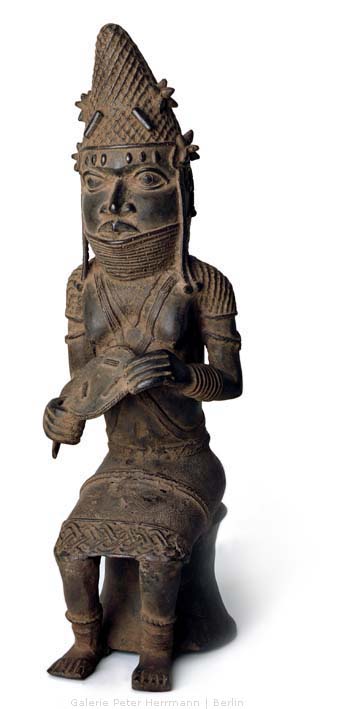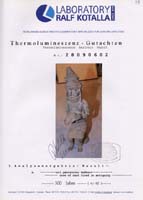Galerie Peter Herrmann |
- | Ancient Art from Africa |
||
 |
| Mother of the King | Thermoluminescence - Expertise |
| Benin, Nigeria About 1700 Bronze. 48 cm |
 |
Description |
The towering coral headdress is an important adornment of the so-called Queen Mother, an appellation that hearkens back to Oba Esigie, who ruled until 1550. Esigie is said to have conferred the title Iyoba (Queen Mother) upon his mother Idia out of gratefulness and respect and to have thereupon inaugurated this type of representation. Since then, all Obas have had the right to grant their mothers the official title Iyoba three years after their enthronement, though only 17 of the 38 Obas of the current dynasty have done so. In general, the Oba never again sets eyes upon his mother once he has assumed his title. As Iyoba, however, the Oba's mother is the only woman to occupy one of the highest posts in Benin, meaning that her son, the Oba, can consult with her on all matters of state. Conferring the title is thus a particularly important decision. After a Queen Mother's death, the Oba dedicates an entire altar to her to which he brings yearly sacrifices in her honour. He also erects a shrine devoted exclusively to her either in the royal palace or at the Iyoba's residence in Uselu, filling it with corresponding memorial heads. This head - unusually girl-like for the depiction of a mother - is highly idealised, suggesting that the idealised acts of enshrinement and worship were more important than actual remembrance in the form of a realistic image. Most depictions of Iyobas were based on Esigie's model and always outfitted with the following attributes: a tall, coral-adorned coiffeur, customary decorative scars on the forehead, coral neck jewellery and a pedestal decorated with wattling or fish-like ornamentation. Vgl.: |
| Similar objects: | Illustration: |
| Staatliche Museen zu Berlin, Ethnologisches Museum | Felix von LUSCHAN: Die Altertümer von Benin, Band 1 -3, Berlin 1919, Tafel 51 und 52. |
Till Förster: Kunst in Afrika, Köln 1988, S. 111. |
Barbara PLANKENSTEINER (Hg.): Benin. Könige und Rituale. Höfische Kunst aus Nigeria, Wien 2007, S. 396. |
| Schmuckmuseum Pforzheim (Ausstellung, 28. Mai bis 27. August 2000) | Ife, Akan und Benin. Westafrikanische Kunst aus 2000 Jahren, Pforzheim 2000, S. 53. |
Nationalmuseum Lagos |
IEkpo EYO, Frank Willett: Kunstschätze aus Alt-Nigeria, Mainz 1983, S. 135. |
Jacques KERCHACHE, Jean-Louis PAUDRAT, Lucien STEPHAN: Die Kunst des Schwarzen Afrika, Freiburg 1989, Abb. 458. |
Liverpool Museums, Liverpool |
William B. FAGG: Bildwerke aus Nigeria, München 1963, S. 43. |
Links |
| Iyoba Idia: The Hidden Oba of Benin |
| Queen Idia - The first Iyoba of Benin Kingdom |